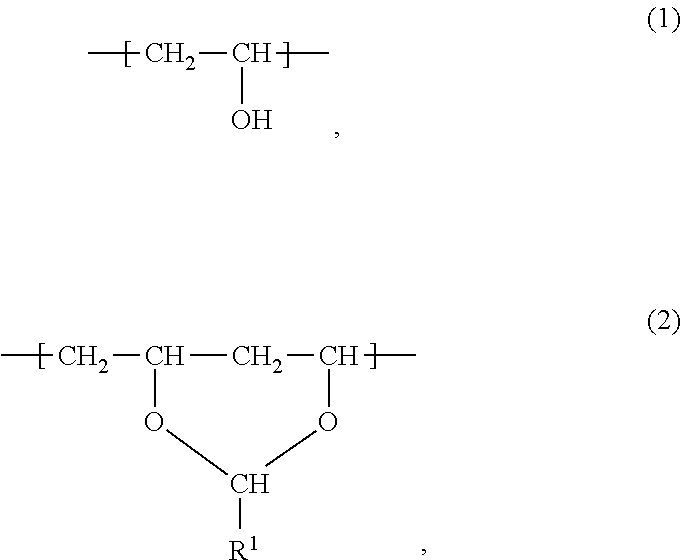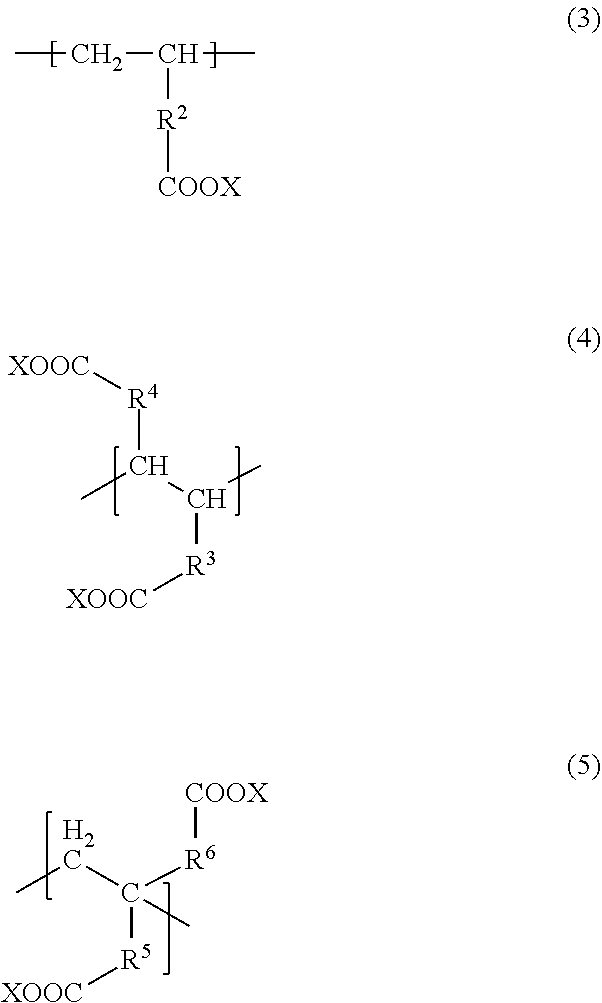Composition for lithium secondary battery electrodes
a lithium secondary battery and electrode technology, applied in the manufacture process of electrodes, cell components, electrochemical generators, etc., can solve the problems of poor binding between a current collector and an active material, insufficient satisfaction of battery weight and energy density, and inability to fully or partially remove active materials, etc., to achieve small amount of binder, excellent dispersibility of active material, and good compatibility
- Summary
- Abstract
- Description
- Claims
- Application Information
AI Technical Summary
Benefits of technology
Problems solved by technology
Method used
Image
Examples
example 1
(Preparation of Composition for Lithium Secondary Battery Electrode)
[0102]To 20 parts by weight of a resin solution containing the obtained polyvinyl acetal resin A (polyvinyl acetal resin: 2.5 parts by weight) were added 50 parts by weight of lithium cobaltate (CELLSEED C-5H available from Nippon Chemical Industrial Co., Ltd.) as an active material, 5 parts by weight of acetylene black (DENKA BLACK from Denki Kagaku Kogyo Kabushiki Kaisha) as a conductivity imparting agent, and 26 parts by weight of N-methylpyrrolidone, and they were mixed using a THINKY MIXER available from THINKY CORPORATION to prepare a composition for a lithium secondary battery electrode.
examples 2 to 14
, Comparative Examples 1 to 5
[0103]Compositions for a lithium secondary battery electrode were each obtained in the same manner as in Example 1, except that the polyvinyl acetal resin (resin type, amount) as shown in Table 2 was used.
[0104]The compositions for a lithium secondary battery electrode obtained in the examples and comparative examples were evaluated for the following parameters. Table 2 shows the results.
(1) Adhesiveness (Peeling Force)
[0105]Evaluation of the adhesion to aluminum foil was performed on the compositions for a lithium secondary battery electrode obtained in the examples and comparative examples.
[0106]Each of the compositions for an electrode was applied to aluminum foil (thickness: 20 μm) to the thickness after drying of 20 μm, and dried to prepare a test sample in which a sheet-like electrode was formed on aluminum foil.
[0107]A piece in a size of 1 cm in length and 2 cm in width was cut out from the sample. The sample piece was immobilized using an AUTOGRA...
PUM
| Property | Measurement | Unit |
|---|---|---|
| mol % | aaaaa | aaaaa |
| mol % | aaaaa | aaaaa |
| glass transition temperature | aaaaa | aaaaa |
Abstract
Description
Claims
Application Information
 Login to View More
Login to View More - R&D
- Intellectual Property
- Life Sciences
- Materials
- Tech Scout
- Unparalleled Data Quality
- Higher Quality Content
- 60% Fewer Hallucinations
Browse by: Latest US Patents, China's latest patents, Technical Efficacy Thesaurus, Application Domain, Technology Topic, Popular Technical Reports.
© 2025 PatSnap. All rights reserved.Legal|Privacy policy|Modern Slavery Act Transparency Statement|Sitemap|About US| Contact US: help@patsnap.com



